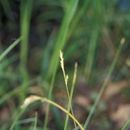Comprehensive Description
provided by North American Flora
Carex bromoides Schkuhr; Wilid. Sp. PI. 4: 258. 1805
Loncoperis bromoides Raf. Good Book 27. 1840. (Based on Carex bromoides Schkuhr.)
Very densely cespitose, in large clumps, the rootstocks fibrillose, sometimes slender, blackish, elongate, the culms 2.5-S dm. high, very slender, ascending or erect, sharply triangular with concave sides, very rough on the angles above, from shorter than to exceeding the leaves, brownish at base and conspicuously clothed with the dried-up leaves of the previous year, the lower bladeless; leaves with well-developed blades 2-5 to a fertile culm, on the lower fourth, the blades erect or ascending, green, flat, usually less than 1 dm. long, 1-2.5 mm. wide, the blades of the sterile-culm leaves longer, often 2-3 dm. long, much roughened on the margins and towards the apex, the sheaths tight, thin and hyaline ventrally and concave and slightly thickened and short-prolonged at mouth beyond base of blade and continuous with ligule; spikes 2-7, pistillate, gynaecandrous, staminate or sometimes androgynous, aggregated (or the lower one or two slightly separate) into a slender head 2-6 cm. long, the spikes narrowly linear-oblong, the lower 5-20 mm. long, 3 mm. wide, with 6-15 erect-appressed perigynia; upper spikes less distinct; lower bracts short-prolonged, shorter than their spikes, the upper scale-like; scales narrowly oblong-ovate, thin, obtusish to acuminate, straw-colored or brownish with 3-nerved green center and white-hyaline margins, as wide below as the perigynia but much shorter; perigynia plano-convex, spindle-shaped, thin, 4.5-5.5 mm. long, 1-1.3 mm. wide, very membranaceous, light-green, rather conspicuously slenderly few-nerved on both sides, narrowly sharp-margined to middle, serrulate above, the lower third of body corky, substipitate and tapering at base, tapering at apex into a slender, strongly serrulate. sharply bidentate beak half length of the body, the dorsal suture reddish-brown-margined; achenes lenticular, occupying upper half of bodies of perigynia, closely enveloped, linear lanceolate, 2 mm. long, 0.75 mm. wide, yellowish-brown, short-stipitate, very short-apiculati .-.hat enlarged at base, jointed with achene, at length deciduous; stigmas two, dark -colored, long, slender.
Tvii; i.i,i m.itv; "Habital ■" Pennsylvania."
ipy woods, Nova Scotia and Quebei toWiscon in, and outhward to Florida, i. and Hidalgo, (Specimens examined from Nova Scotia, Quebec, New Brunswick, Hampshire, Vermont . Rhode Island, Connecticut, New York, N<-»
uoibia, Virrini i olina, ! louth I
Ontario, Obio, Michigan, Indiana, Kentucky, Wi con in, Louisiana, Hidalgo I
Ituhr, Riedgi pi Xxx.) 176 Boott, 111 I irea ' pi '27, Britl fc Brown, HI pi [an, I Wi
- bibliographic citation
- Kenneth Kent Mackenzie. 1931. (POALES); CYPERACEAE; CARICEAE. North American flora. vol 18(3). New York Botanical Garden, New York, NY
Carex bromoides: Brief Summary
provided by wikipedia EN
Carex bromoides, known as brome-like sedge, brome-sedge, and dropseed of the woods, is a species of sedge in the genus Carex. It is native to North America.
- license
- cc-by-sa-3.0
- copyright
- Wikipedia authors and editors

